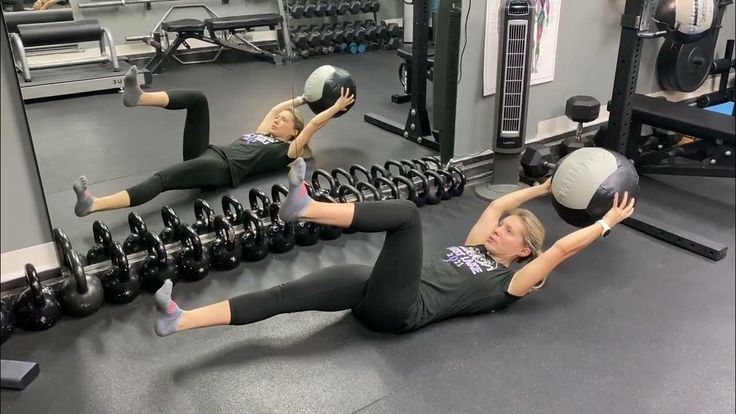1 de May de 2025
Lower Back Exercises with Medicine Ball: Exercise Guide, Tips and Benefits
Lower back exercises with a medicine ball offer an engaging way to build core strength, enhance spinal stability, and improve athletic performance. The resistance and dynamic nature of the ball help activate deep stabilizers that protect the lumbar spine. Whether you’re an athlete working to boost performance or someone aiming to prevent back discomfort, these exercises are a smart, low-impact addition to any strength and conditioning program.
What Are Lower Back Exercises with a Medicine Ball?
These are movements specifically designed to strengthen the muscles that support the lumbar spine while improving balance, coordination, and mobility. The medicine ball’s load and instability require your core and posterior chain to work harder to maintain control. They can be incorporated into warm-ups, strength circuits, or mobility flows. Their versatility makes them suitable for athletes, rehab settings, and anyone focused on injury prevention or enhanced movement quality.

How to Do Lower Back Exercises with a Medicine Ball Properly
- Choose the right exercises: Select 3–5 movements targeting the lower back and core.
- Use appropriate weight: Start with a manageable load to focus on control and precision.
- Set up with good posture: Position yourself securely and maintain a neutral spine.
- Engage your core: Brace your abdominals before each movement to protect your lower back.
- Perform with control: Focus on slow reps and full-body tension rather than speed.
- Pair with mobility drills: Support flexibility and long-term back health by including stretching post-exercise.
- Progress gradually: Add reps, sets, or weight only when form remains solid.
Muscles Worked by Lower Back Exercises with a Medicine Ball
While focused on the lower back, these exercises engage multiple muscles:
- Erector spinae: Primary spinal stabilizers.
- Glutes and hamstrings: Support hip extension and pelvic alignment.
- Transverse abdominis and obliques: Stabilize the trunk.
- Hip flexors: Assist during movement and postural control.
Benefits of Lower Back Exercises with a Medicine Ball
- Core and Spinal Stability: Strengthens deep musculature to support posture.
- Improved Mobility: Encourages better range of motion and control in the lumbar spine.
- Functional Strength Gains: Transfers to sport, lifting, and daily tasks.
- Injury Prevention: Reduces the risk of overuse or postural-related back issues.
- Fatigue Management: A great option during high-volume training phases when heavy loading isn’t ideal.
Common Mistakes to Avoid
- Using Too Much Weight: Can compromise technique and increase injury risk.
- Overextending the Spine: Small, controlled movements are more effective and safer.
- Ignoring Core Engagement: Always activate your abs to protect your back.
- Moving Too Fast: Tempo matters—slower reps increase activation and awareness.

Variations of Lower Back Exercises with a Medicine Ball
- Medicine Ball Dead Bug
Lie on your back, hold the ball between hands and knees. Extend opposite arm and leg, return, then switch sides. - Medicine Ball Superman Lift
Lie face down, holding the ball. Raise arms, chest, and legs, pause, then return. - Prone Ball Extensions
Lie face down with the ball under your hips. Gently lift your torso using your lower back. - Russian Twists with Medicine Ball
Sit back slightly, rotate side to side with the ball. Move from the torso, not just arms. - Seated Ball Reaches
Sit tall with legs extended. Reach forward while holding the ball overhead, keeping your back flat.
How to Include Lower Back Exercises with a Medicine Ball in Your S&C Workout
Include 2–3 exercises as part of your accessory or mobility blocks. Aim for 2–3 sets of 10–15 reps, focusing on technique. These moves pair well with anti-extension drills, core circuits, or glute work. They’re especially useful in deload or recovery sessions to reduce fatigue while maintaining spinal health.
FAQs About Lower Back Exercises with a Medicine Ball
Are medicine balls good for the back?
Yes—they offer safe, effective resistance for improving strength, control, and spinal stability when used properly.
How do you stretch your lower back with a medicine ball?
Lie back over the ball to gently extend the spine, or use it as a support during seated or kneeling stretches.
What is the single best exercise for lower back pain?
There’s no one-size-fits-all, but dead bugs, glute bridges, and gentle extensions are typically recommended for controlled strengthening.
What are the pros and cons of medicine balls?
Pros: Versatile, portable, excellent for dynamic strength.
Cons: Requires control and proper form; heavy balls may be challenging for beginners.
Lower back exercises with a medicine ball offer a dynamic and functional approach to spinal health and core development. By integrating them into your strength and conditioning routine, you build resilience, improve posture, and reduce the risk of injury—all while managing fatigue and supporting long-term athletic development.
